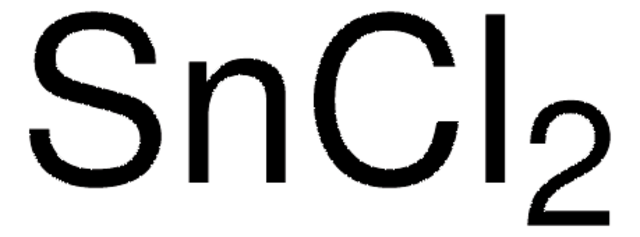243523
Tin(II) chloride dihydrate
ACS reagent, 98%
Sinónimos:
Stannous chloride dihydrate
About This Item
Productos recomendados
grade
ACS reagent
Quality Level
assay
98%
98.0-103.0% (ACS specification)
form
powder or crystals
reaction suitability
reagent type: catalyst
core: tin
bp
652 °C (lit.)
mp
37-38 °C (dec.) (lit.)
solubility
hydrochloric acid: passes test
water: soluble
anion traces
sulfate (SO42-): passes test (lim. ~0.003%)
cation traces
Ca: ≤0.005%
Fe: ≤0.003%
K: ≤0.005%
Na: ≤0.01%
Pb: ≤0.01%
SMILES string
O.O.Cl[SnH2]Cl
InChI
1S/2ClH.2H2O.Sn/h2*1H;2*1H2;/q;;;;+2/p-2
InChI key
FWPIDFUJEMBDLS-UHFFFAOYSA-L
¿Está buscando productos similares? Visita Guía de comparación de productos
General description
Application
It plays the role of a catalyst in the synthesis of 3-aminoimidazo[1,2-a]pyridines. It can be used as precursor for the synthesis of tin dioxide (SnO2) nanostructures by thermal degradation at temperature between 400-700 under controlled conditions.
signalword
Danger
Hazard Classifications
Acute Tox. 4 Inhalation - Acute Tox. 4 Oral - Aquatic Chronic 3 - Eye Dam. 1 - Met. Corr. 1 - Skin Corr. 1B - Skin Sens. 1 - STOT RE 2 Oral - STOT SE 3
target_organs
Cardio-vascular system, Respiratory system
Storage Class
8B - Non-combustible corrosive hazardous materials
wgk_germany
WGK 3
flash_point_f
Not applicable
flash_point_c
Not applicable
Certificados de análisis (COA)
Busque Certificados de análisis (COA) introduciendo el número de lote del producto. Los números de lote se encuentran en la etiqueta del producto después de las palabras «Lot» o «Batch»
¿Ya tiene este producto?
Encuentre la documentación para los productos que ha comprado recientemente en la Biblioteca de documentos.
Los clientes también vieron
Nuestro equipo de científicos tiene experiencia en todas las áreas de investigación: Ciencias de la vida, Ciencia de los materiales, Síntesis química, Cromatografía, Analítica y muchas otras.
Póngase en contacto con el Servicio técnico



